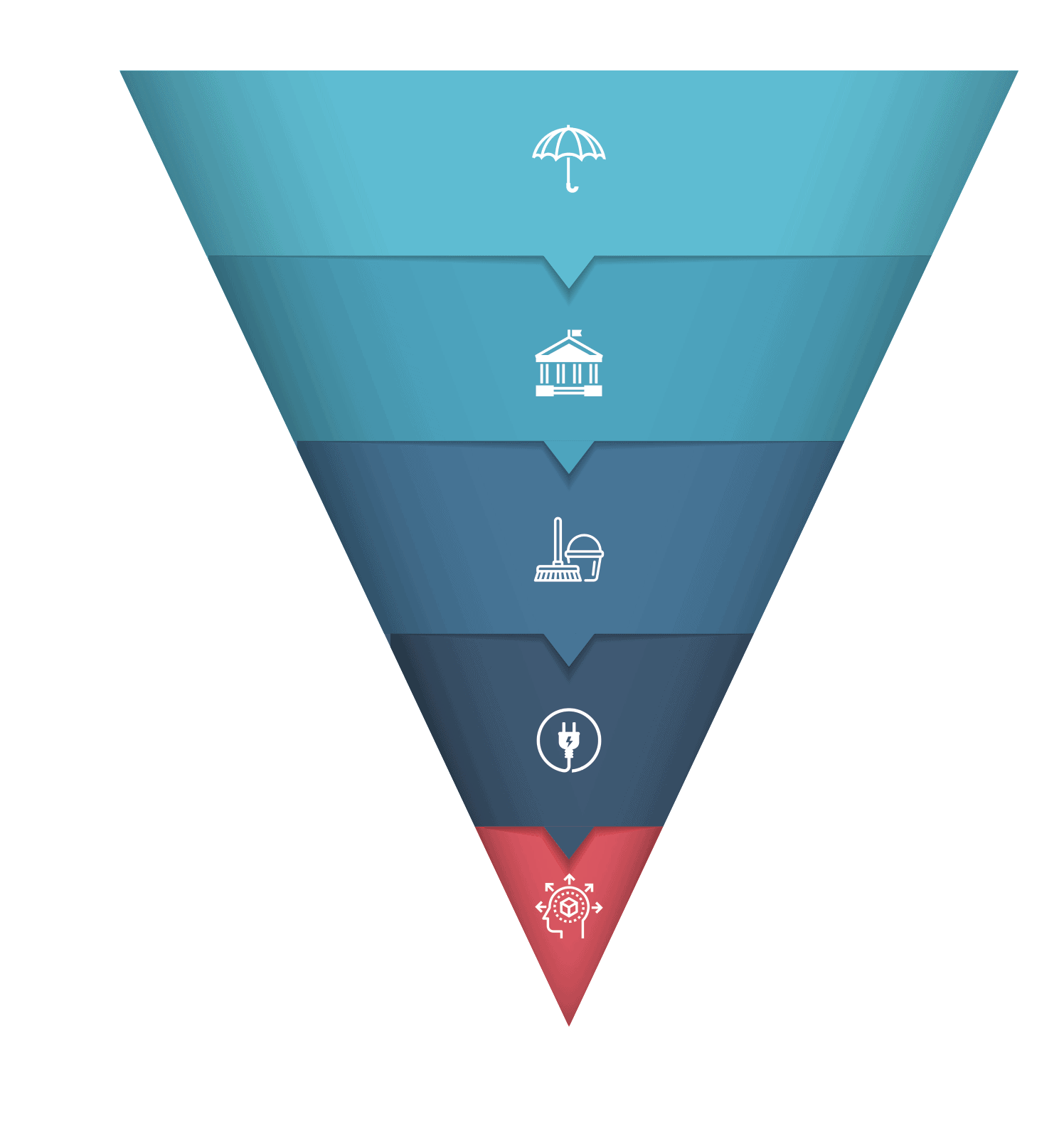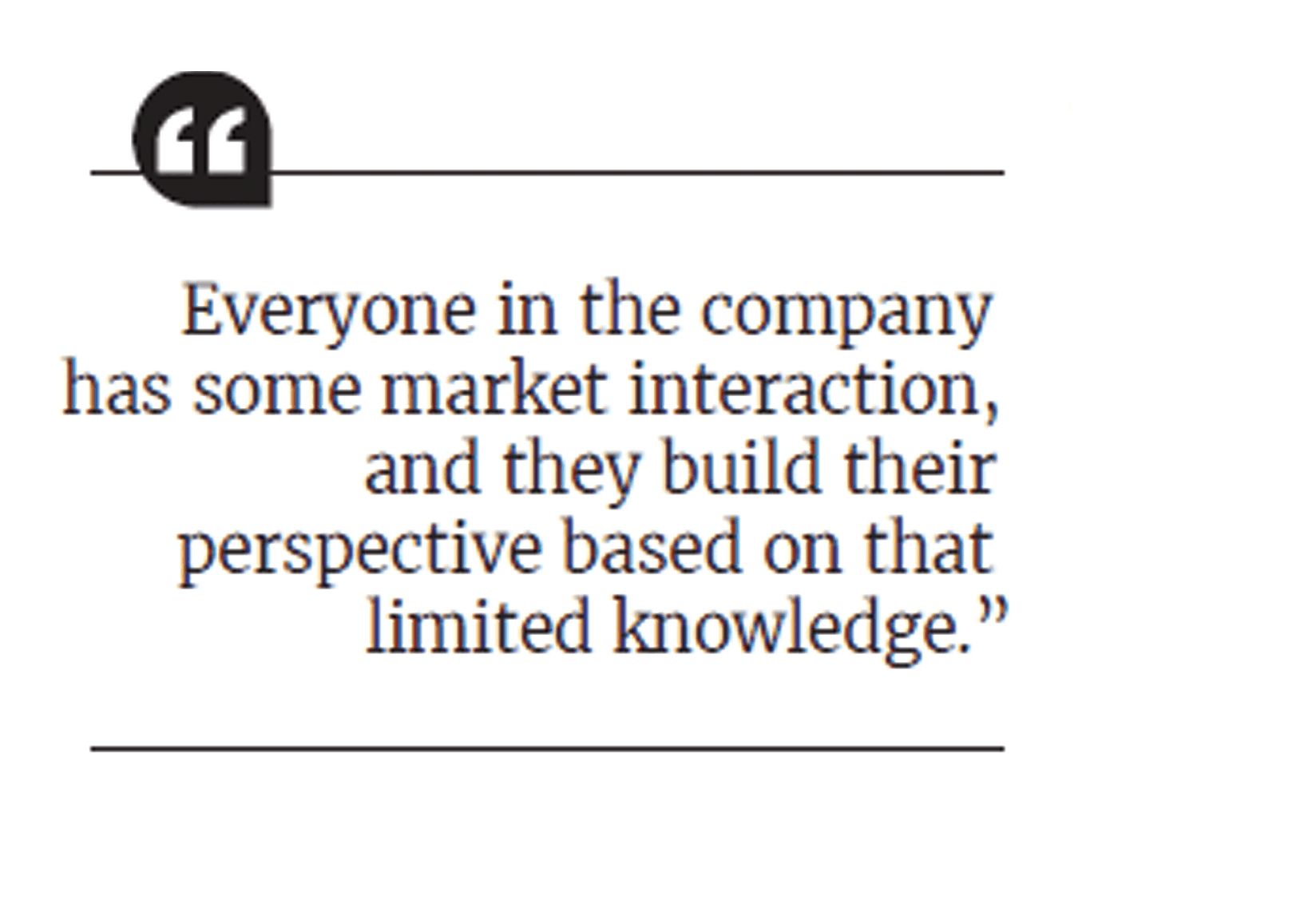Many companies treat market research like an isolated event: perform a survey/focus group/ride-along and use whatever they hear as the market truth de jour. Then a new insight comes to light, the company takes a different direction, and so on.
Chances are that your company is in a similar situation. You spend a fortune on focus groups, user conferences, and surveys in the race to gather market data, but are you using that data? Are you identifying and validating trends rather than reacting with a fire drill every time you hear something new? For many companies, the answer is “no.” So, if your company is spending a fortune gathering market data but not using it, you’re not alone.
A cone of knowledge solves this problem. For those who’ve taken Pragmatic Institute’s Foundations course, you’ve heard me talk about this. For those who haven’t, a cone of knowledge is what I call the act of sweeping all market knowledge into an orderly pile that allows for thorough analysis and, hopefully, better decision making when it comes to building great products.
Another problem a cone solves is the destructive force of knowledge bombs. Everyone in the company has some market interaction, and they build their perspective based on that limited knowledge. “What about the survey sales just did?” “That isn’t what I heard at the trade show!” “We’re onboarding Customer X and we heard …”
This knowledge often is surfaced at the last minute, when a launch is being finalized or the strategy is about to be presented to the board. A well-timed knowledge bomb can blow up product roadmaps, releases—even revenue. One Pragmatic student shared with me that he and his team had held three “final review” meetings in the previous six months. A major knowledge bomb was thrown each time, resulting in the delay of an important launch, and a major shift in product scope and go-to-market strategy. “Seriously, I have no idea whether the changes are good or bad,” he said. “All three knowledge bombs came from three single data points.”
A cone of knowledge enables the product team to mitigate these issues and do its job as the expert on the market with more credibility and impact. The following steps explain a basic and inexpensive way to develop a cone of knowledge that won’t take a lot of extra time. There are other ways to build your cone, but this is how I’ve done it—and how I’d improve it—based on experience.
Step 1: Define Scope
You can build a cone from wherever you are in the organization, without approvals or budget — all you need is a cataloging tool, such as a spreadsheet program, and a repository or ability to access the market data that’s been gathered. Begin with one product or solution. Use the tools you have on-hand, prove the concept and expand. Don’t try to do too much too fast or change everyone.
Step 2: Establish a Structure
Don’t get bogged down in this step; rather, keep things simple. Focus on
- Roles: Clarify with other team members who will be responsible for aggregating, organizing, and analyzing data as well as making recommendations based on the data and communicating this data-driven direction to the rest of the company. Each of these steps may have a different owner. Are you the only person on the team? Great, this step is easy!
- Taxonomy: Tag all incoming data with a persona, market, and product label. Use the personas and markets you’ve already defined, even if they’re incomplete. Don’t have those? Use your market knowledge to make a reasonable guess. You can add or validate details as you move forward (that’s a benefit of the cone!). Then, add a “market problem” field and an ability to track the source of the information.
- Systems: If you can afford an aggregation/analysis tool like productboard, that’s great. No budget? Use the tools you have: Excel, Dropbox, Slack. Regardless of what you use, you need to store data so it can be accessed and analyzed by persona, market, product, or problem. For one of my cones, I keep a market-problems table (similar to Figure 1) in Excel with links to the actual documentation, which was in Dropbox.
- Scoring: Minimally, record the number of times you’ve heard the problem so you can quantify the evidence you have that the problem exists. You can add scoring elements to weight for specific markets or personas, level of impact to the market, and myriad other attributes. Align your scoring system with your corporate strategy. If you’ve taken Pragmatic Institute’s Focus or Build classes, you already have some ideas on how to create a scoring system.
- Input channels: One of the most challenging parts of building a cone of knowledge is getting people to feed it. Make it as easy as possible. Set up a dedicated voicemail, Slack channel, or email address. Allow colleagues to text information to you. Any way your company communicates, enable that channel to gather data. Just get the data.
Step 3: Sweep Up What Exists
When I teach, I talk about having teams go on scavenger hunts for market research conducted by other departments, statistics from our website, and so on. Ask everyone but limit the age of information to 24 months or fewer. Scan hard copies and get access to those that are already in electronic format. If someone refuses to give you information, note it and move on—you’re not trying to change company culture, you’re trying to get access to anything you can.
Step 4: Plug Internal Sources In
Ask sales and customer service to give you access to recorded calls. Ask legal to email experiences with contract negotiations. Let IT know about your Slack channel. Enter what you hear at trade shows. One by one, create ongoing streams of information with teams that are in touch with the market. If they say no, refer back to the last sentence of Step 3.
Step 5: Use that $h!t
Schedule time to regularly analyze what you collect: formulate problem statements, determine where follow-up would be helpful, and prioritize the ideas with promise. Try to set aside time for this once a week, with 75% of your time spent on analysis and 25% on the organization. It may sound impossible but commit to doing this for one hour every week. I guarantee, no one will notice if everything on your to-do list is one hour late. The results of this analysis should be new positioning documents, roadmap items, and requirements. Finally, as you begin leveraging the data to make better decisions, make sure you share your methods and give shout-outs to those in the organization who are feeding the cone—you can’t do this without them!
Get the Most Out of Market Information
The cone of knowledge allows you to maximize the time, effort, and money your organization already spends on collecting market information. It won’t happen overnight, and that’s OK. It won’t be perfect, and that’s OK, too. It will have a positive impact on your effectiveness and influence—and that’s what you’re looking for.
Learn More:
Find these related resources on PragmaticInstitute.com
Certification Courses
- Foundations: Uncover the Secrets of Creating a Market-Driven Organization
- Focus: Strategic Product Planning
- Market: Drive Revenue Growth, Customer Acquisition and Brand Awareness
Webinars
- Tuned In Product Teams: Using Market Focus to Overrule Opinions and Politics
- The Transformational Power of the Market
Podcasts
Articles
Author
-
Diane Pierson has more than 20 years of experience delivering product management and marketing results in the big data/analytics, publishing and digital marketing industries. Prior to joining Pragmatic Institute as an instructor, she delivered more than $100 million in revenue to companies, including Dun & Bradstreet, LexisNexis, InfoGroup and Copyright Clearance Center. In addition to holding multiple vice president and general management roles, she started a consultancy specializing in go-to-market strategy and organizational alignment. She brings a results-focused understanding and executive mindset to her role as a Pragmatic Institute instructor. Contact her at [email protected].










